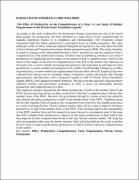| dc.description.abstract | KIMAKA DAVID SSEKIBAALA (2008-M102-20036)
The Effect of Productivity on the Competitiveness of a Firm: A Case Study of Member Organisations of the Private Sector Foundation Uganda
According to the study conducted by the Investment Climate Assessment (an arm of the World Bank group), low productivity has been identified as a major factor of low competitiveness of Ugandan enterprises relative to its neighbours and internationally. The investment climate assessment finds that labour productivity is particularly lower in smaller enterprises. The value added per worker in micro, small and medium enterprises in Uganda is in fact only about one third of that in Kenya and Tanzania (Investment climate assessment report 2004). This study, therefore, is aimed at looking at the relationship between a firm‟s productivity and the respective firm‟s competitiveness in the market and economy. It further aims at establishing whether or not a firm‟s productivity in Uganda has had an impact on the respective firm‟s competitiveness. And if so the nature of the impact on the level of competitiveness of the firm in the markets The objectives of the study were: to assess whether increasing innovativeness and technology in staff improves their productivity, to assess whether increasing the level of skills of staff through training has an effect on productivity, to assess whether the organisational structure affects the staff. Empirical data were collected from various sources including country competitive reports and primary data through questionnaires and interviews with a purposive sample of staff of Private Sector Foundation Uganda (PSFU), and Uganda Investment Authority. The data were then analysed using descriptive statistical analysis and quantitative techniques in order to assess the relationship between productivity and competitiveness of a firm.
The empirical evidence showed that the labour productivity of staff of the member firms of the PSFU has been growing and has an effect on the level of the firm‟s competitiveness with the other member firms of the PSFU. However, the government through its various actions has indirectly also affected the labour productivity of staff of the member firms of the PSFU. Therefore, given the fact that Ugandan firms are going to face competition from firms from the neighbouring states as a result of joining the East African common market, there will be a need to improve the labour productivity of staff of the member firms of the PSFU. This will help improve the sustainability of the PSFU member firms and this research has gone forward to recommend some of the steps that PSFU member firms should take to improve on the labour productivity of their staff so that they improve on their competitiveness levels in the East African common market. The study has also recommended other areas for further research which will help build up this study to another level in terms of improving the labour productivity of staff to achieve improved competitiveness in the market.
Key Words: Effect, Productivity, Competitiveness, Firm, Organisations, Private Sector, Foundation | en_US |


